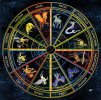Another "random" thought that may be either relevent, or utter nonsense (more likely lol).
When interpreting data, we operate within a definite framework. In Astronomy, the framework is 3D reality and most often, nonelectric "empty" space. Most importantly, we automatically think of physical reality as devoid of consciousness/information as an underlying, and yet unassuming unconscious assumption.
Until there is some practical reality someday to gravitational waves, all we see of the outer space is what and how photons at whatever wavelengths arrive and how they are detected, etc. We see what the universe allows us to see in other words.
Now to give an analogy, on a hot day, the ground is heated by the sun and a strong gradient of temperature builds up in the air right above it. Light that travels almost parallel to the ground is strongly refracted, which gives the mirage effect. Light from other directions, especially the one whose propagation is parallel to the temperature gradient is as usual. Thus, there is a certain privileged direction where we have a bizarre optical distortion because of the nature of the medium. Now suppose that the solar system is in a discharge mode with Nemesis. We can imagine a connecting thread, straight or otherwise, making the connection between the objects. The question one could ask is how does light propagate in the direction of that thread. Does it cause some optical distortion that makes any object observed in that direction fall below detection threshold? If it is the case, than maybe we have a blindspot in that very particular direction.
The thing is that as a planet with so much density of consciousness (at least in potential), it is possible that the universe offers us with a special treatment such as that we cannot extrapolate from systems we observe from the outside (any double star system) to what we can see from the inside. The image of the fish in the ocean comes to mind. Solar eclipses and other "coincidences" may be a way to remind us that we indeed occupy a special place in the "local?" universe.
To draw more from mythology, if we take the story of Atlantis literally, how come such a civilization that conquered the solar system couldn't anticipate what happened? One possibility is the above-mentioned possible blind-spot, another possibility is transdimentional phenomena. For instance, it is very possible that a cycle-ending cometary bombardment would be caused by a certain ratio X of comets from 3D, and another ratio from comets that suddenly emerge from elsewhere. Same with Nemesis. One component of its behaviour could be 3D physics, and another part could be from (3+n)D physics. Since the Wave is "realm merging" of some sort, which is hard to describe/model/predict/define etc., the only rational (not logic) approach to the thing would be that: If we see Nemesis, there is a possibility that it is there, but if we don't see it, it doesn't mean that it isn't there, it just means that there is a possibility that it isn't there, which implies a possibility that it is there. Since the rules of the games are blurred, and the rules of the known cannot be applied with certainty to the rules of the unknown, it's only a matter of conjecture.
OSIT FWIW



